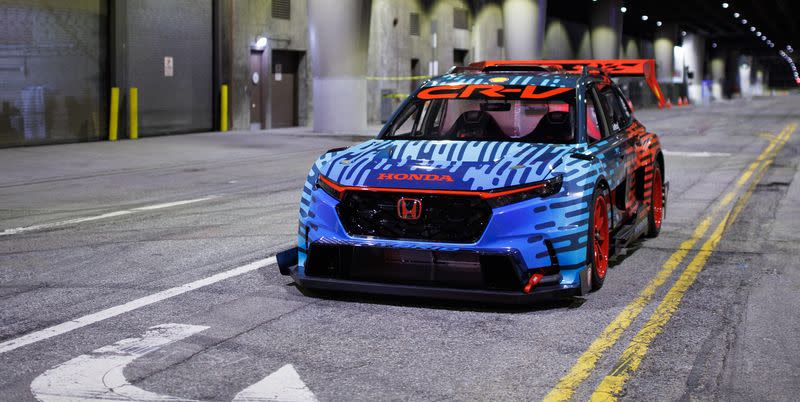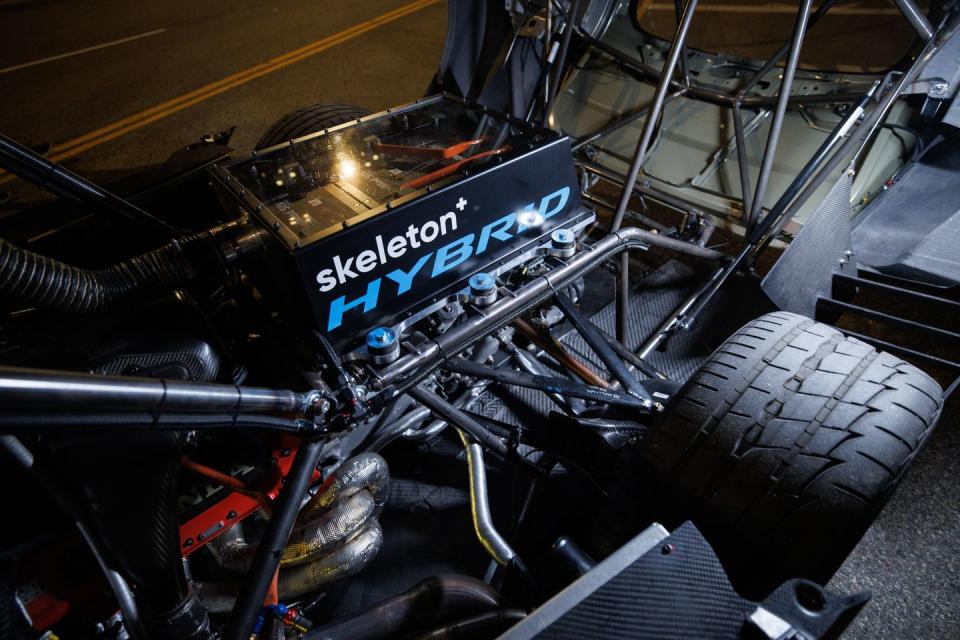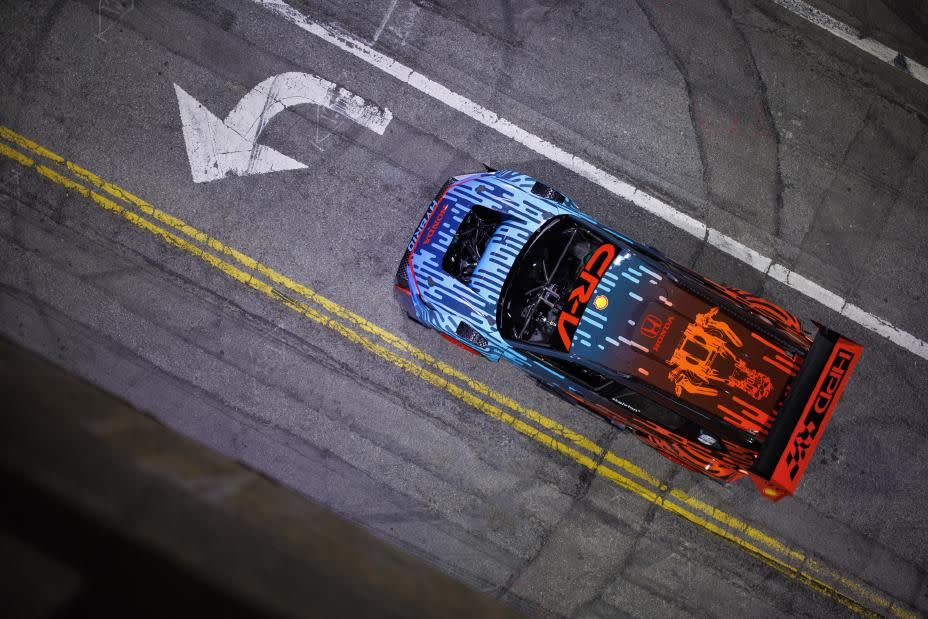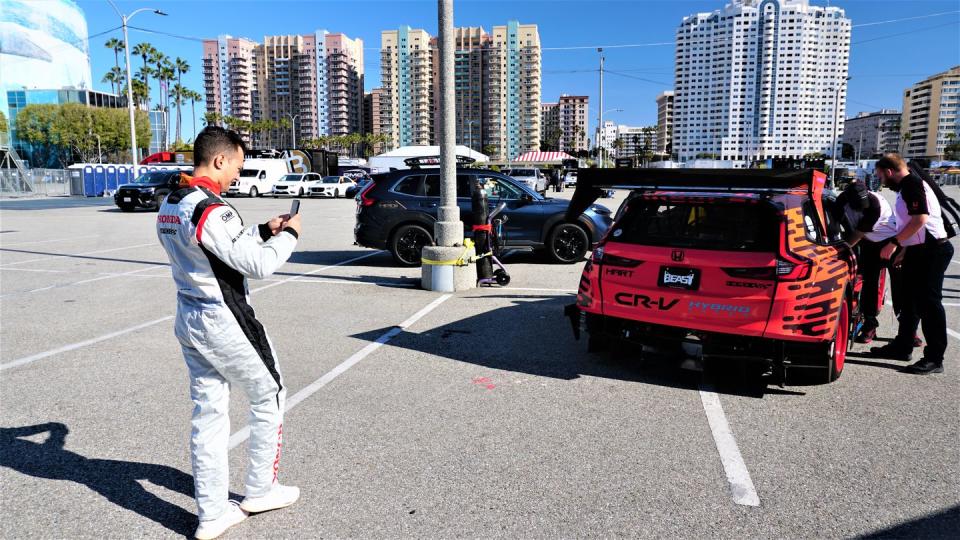One Lap of Long Beach in an IndyCar-Powered Honda CR-V

The entire IndyCar open-wheel racing series is officially switching to hybrid powertrains in 2024, but Honda created this IndyCar-powered hybrid CR-V now to show off next year’s racing powertrain, and took me along for a ride in it.
“This was built as an engineering platform for us to study electrification and hybridization for motorsports, as well as to tie into the hybrid side of production cars,” said James Nazarian, Honda project leader for this screaming orange-and-blue contradiction.
Why a CR-V and not, say, an Acura NSX?
“It’s kind of an homage to old Group B, DTM, you know, the wildest of the wild racecars,” said Nazarian.
It helps that the CR-V is the number-one-selling Honda (or Acura) product by far, double the next-closest thing in the model lineup across both divisions, with a quarter-million US sales last year. If only Honda was entered in WRC.
But no one’s complaining.
The heart of “The CR-V Hybrid Racer” is its 2.2-liter electrically assisted hybrid powertrain. Note we said 2.2-liter and not 2.4. Neither Honda nor Chevrolet, the two engine suppliers to the IndyCar series, could afford, or wanted to spend the money to finish development of the 2.4-liter hybrid IndyCar wanted. But that’s another story.
“The CR-V Hybrid Racer places a 2.2-liter twin-turbocharged, electrified Honda V6 IndyCar power unit and transmission under 2023 Honda CR-V Hybrid bodywork to create the ‘rolling laboratory’ for the continued development of electrified technology by Honda and HPD,” Honda said in a statement.

While all hybrid powertrains around the world, except the Lamborghini Sian, have used batteries to store their electricity, this car—and the Sian—use ultracapacitors. Specifically, the CR-V uses a bank of Skeleton Supercapacitors.
A supercapacitor differs from a battery in that it can absorb and discharge electricity much quicker. While it can store regenerative energy, a battery takes hours to recharge, and then it discharges its juice at a relatively slow rate. An ultra- or supercapacitor gulps electricity in huge amounts and can unload it very quickly, which is what you want in a race car.
“Supercapacitors are the best technology to provide braking energy recovery and boost acceleration,” Skeleton said. “The low internal resistance of Skeleton’s supercapacitors, their high cyclability, and good resistance against aging make them the best choice for hybrid racing car drivetrains.”
The body into which all this hybrid race technology is bolted is an actual 2023 Honda CR-V, at least from the beltline up. There’s even a working hatchback in the rear. The HPD team built a custom roll cage to stiffen the whole structure enough to hold the 800-hp output without twisting it apart like a used Dixie Cup. The rear suspension and Brembo brakes are straight from a Dallara IR-18 Indy car, while the front setup and brakes are based on the Acura NSX GT-3 Evo22.
There are only two seats in the CR-V, one for the driver and one for a lucky—or terrified—passenger. When Honda invited me to experience a lap at speed around the street course at the Acura Grand Prix of Long Beach, I actually had the temerity to ask if I could drive. Ha! I’ve driven Indy cars, Formula 1 cars, concept cars, and even once drove a pedal-powered full-sized banana (it was an “art car”).
“No,” Honda said.

So instead, I found myself zipping into Honda Nomex in the LBC for a ride in the CR-V’s passenger’s seat. Nazarian would be driving. Life is full of compromises.
Street courses aren’t necessarily dangerous as long as you remember to hit the brakes soon enough, so I wasn’t worried about crashing or anything. I was just wondering how many Gs a CR-V-clad IndyCar could pull, and how quickly an 800-hp Honda could accelerate.
I still don’t know.
The problem with these media day rides is they have to accommodate everyone from the perfectly coiffed local TV newscaster to the irony seeking “influencer” to the Long Beach city employee who had snuck onto the track for a ride. I was somewhere in between all of those. Problem was, there was apparently a 100-mph speed limit for these runs, which sounds to me like an insurance restriction, but I could never track anybody down who could say if it was.

Plus, we were lined up behind a trio of NSXs giving rides to gawd-knows-who those people were but apparently none of them wanted to go very fast. Now, I know 100 mph may sound like a high rate of speed if you’re a breathless newscaster describing the lastest LA car chase, but it’s really not fast at all from the inside of a high-powered CR-V on a street course. In fact, the real CR-V officially tops out at 124 mph, so, had there been a stock street CR-V on the track with us, it would have passed us! Oh the ignominy.
But I’m not complaining. I’ve always been intrigued by ultracapacitors for their efficiency. Since most mild hybrids in street cars are more for launching off the line better, ultracapacitors—or supercapacitors or whatever they’re called nowadays—would seem to be a more efficient means of energy recapture and storage for a lot of uses. I’ve always thought those mechanical arms that lift garbage cans and dump them into the garbage truck should be powered by ultracapacitors, for instance, but I’m no engineer.
In less than a lap we were back in the pits and the next journalist, Autoweek alum Mac Morrison, was getting in. “Watch out for the red Lola,” I told him, but he just looked at me like I was nuts.

 Yahoo Autos
Yahoo Autos 